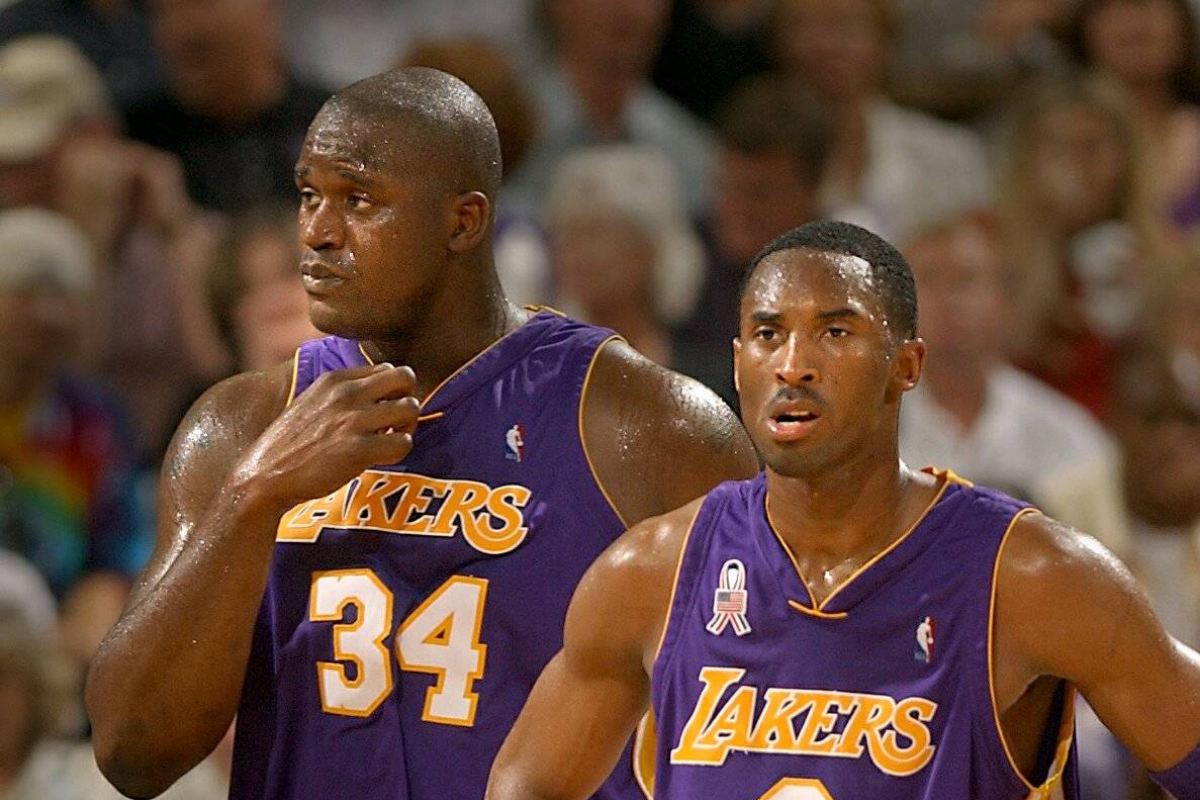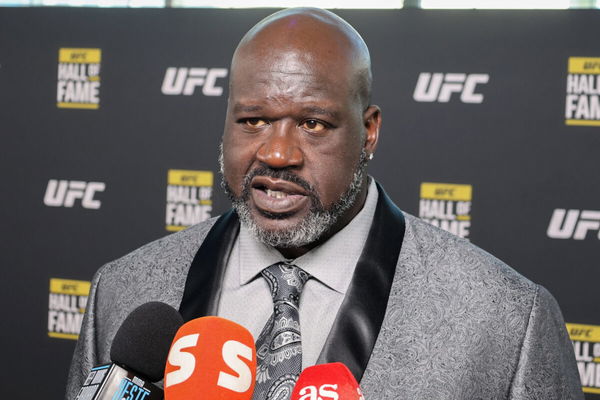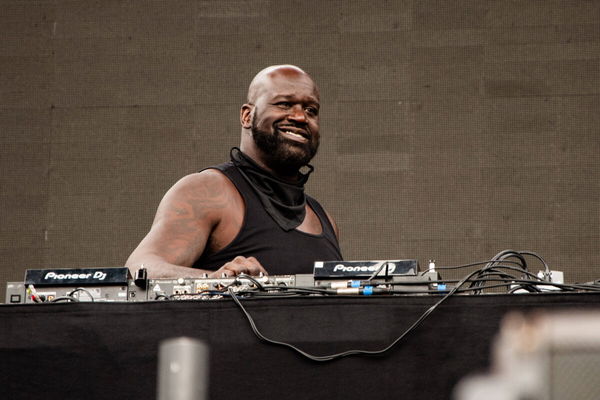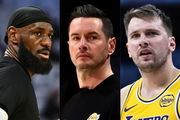
Imago
May 2, 2006; The former Laker s teammates KOBE BRYANT and SHAQUILLE O NEAL have cause to celebrate once again. This time they are both dads, their wives each gave birth to girls, six minutes apart! Gianna Bryant was born to Vanessa at 2:03am PDT in Orange County and Meara O Neal was born to Shaunie in Florida 4:53am EDT. FILE PHOTO: Lakers Shaq O Neal and Kobe Bryant ponder the situation during Kings game 5 win in western conference finals at Arco May 28, 2002. Sacramento bee Chris Crewell/ZUMA Press PUBLICATIONxINxGERxSUIxAUTxONLY – ZUMAG SH 20020922_aab_s76_491 Copyright: xCHRISxCREWELLx

Imago
May 2, 2006; The former Laker s teammates KOBE BRYANT and SHAQUILLE O NEAL have cause to celebrate once again. This time they are both dads, their wives each gave birth to girls, six minutes apart! Gianna Bryant was born to Vanessa at 2:03am PDT in Orange County and Meara O Neal was born to Shaunie in Florida 4:53am EDT. FILE PHOTO: Lakers Shaq O Neal and Kobe Bryant ponder the situation during Kings game 5 win in western conference finals at Arco May 28, 2002. Sacramento bee Chris Crewell/ZUMA Press PUBLICATIONxINxGERxSUIxAUTxONLY – ZUMAG SH 20020922_aab_s76_491 Copyright: xCHRISxCREWELLx
Shaquille O’Neal has always been larger than life, both on the court and off, in his personality and on Inside the NBA. But recently, the NBA legend revealed that his nights have been quieter, with his dreams replaying the championship years in Los Angeles alongside Kobe Bryant. It’s been over five years since Bryant’s tragic passing, but for Shaq, those moments have come alive vividly, night after night. Behind these dreams lies a health struggle that nearly went unnoticed.
Watch What’s Trending Now!
In a recent interview, O’Neal said, “If I lay there the first five minutes, I don’t go to sleep, then I just start dreaming, and last night I was dreaming about me and Kobe and all the championships we won. just replayed and recreated us riding in the parade and just having good times. Before I knew it, it was 9 a.m.”
He called it “dreamful attraction,” a poetic, perhaps spiritual concept. But experts call it a symptom. For years, Shaq has struggled with untreated sleep apnea, a condition that distorts the brain’s REM cycles and disrupts rest, causing hyper-real dreams. In the 53-year-old’s case, it’s nostalgia meeting physiology; memory meeting a long-ignored warning.
ADVERTISEMENT
He admitted that he didn’t pay it much attention at first. “I was just tired all the time, and then I met this gentleman from Harvard who was a doctor, and he told me about [OSA], but I was still in my superhuman phase as I was still playing, so I didn’t pay attention.” The words hit hard. That Superman phase defined not just Shaq’s career, but his mindset at the time: he was someone who broke backboards and believed fatigue was just weakness. That mentality made him a champion, but also blinded him to his body’s signals.

Imago
Sport Bilder des Tages Former American basketball player Shaquille O Neal speaks to the press during an event at the UFC Hall of Fame in Las Vegas, USA, 26 June 2025. Shaquille O Neal at the UFC Hall of Fame ACHTUNG: NUR REDAKTIONELLE NUTZUNG PUBLICATIONxINxGERxSUIxAUTxONLY Copyright: xOctavioxGuzmánx AME8987 20250627-55017248027_1
Why does this matter beyond restless nights? Repeated oxygen dips and sleep fragmentation drive sympathetic nervous system activation, inflammation, and blood-pressure spikes, mechanisms that raise the long-term risk of hypertension, stroke, arrhythmia, and heart failure. Observational and meta-analytic studies link untreated OSA with substantially higher cardiovascular risk; treating OSA (often with CPAP or other therapies) reduces many of those risks.
ADVERTISEMENT
The problems eventually piled up. He started having chronic fatigue, breathing issues, and erratic sleep, and remembers doctors telling him plainly: “Do you have sleep apnea? That needs to change.”
Today, the former Magic center is working with medical company Lilly, and their initiative ‘Don’t Sleep on OSA‘ to “help people prevent the certain things that I went through.” He also added that he wants to raise awareness and encourage people to visit doctors to “try to figure out what’s going on.”
ADVERTISEMENT
The Wake-Up Call That Changed Shaquille O’Neal’s Life
This isn’t the first time Shaquille O’Neal has talked publicly about his health. Previously, the Laker legend talked about the initial diagnosis and how it served as a gut-punch, stopping him cold in his tracks. Shaq had spent years ignoring his health, and his body had started to pay the price. “I wasn’t paying attention,” he admitted. “One day I looked down and said, ‘Damn.’ My belly was way over my belt.”
For many patients starting therapy, there’s also a short, paradoxical increase in intense dreaming, REM rebound as the brain restores lost REM sleep. That can be confusing: better sleep, but more memorable dreams at first. Over weeks to months, though, sleep architecture usually stabilizes, and dream intensity typically diminishes.
ADVERTISEMENT

Imago
August 11, 2023, San Francisco, California, United States: DJ Diesel, better known as Shaquille O Neal or Shaq, DJs the Twin Peaks stage during Day 1 of Outside Lands Music Festival on Friday August 11th, 2023 in San Francisco, California. Shot by San Francisco United States – ZUMAs181 20230811_zea_s181_026 Copyright: xAnniexLesserx
After his retirement in 2011, O’Neal had slipped into poor habits: no checkups, junk food, and medicine just to get out of bed. “I’m a creature of habit: I love sandwiches. I love burgers,” he confessed. “I was eating nothing but sandwiches – for lunch, dinner, even snacks.” Then, during the pandemic, he was delivered a wake-up call from his doctor. “When someone hits you with that three-letter word that starts with D and ends with E, things change.” Things were laid bare: his kidneys were failing, and he was suffering from undiagnosed sleep apnea. Without treatment, he faced the risk of heart failure or stroke.
Top Stories
A’ja Wilson, Bam Adebayo Issue Strong Statement Against Rachel Nichols’ Question About Couple’s Privacy

“Why Wouldn’t I?”- LeBron James Defies JJ Redick’s Directive, Takes FT Off Luka Doncic

Caitlin Clark Surpasses LeBron James, Stephen Curry With 136,000 PSA Announcement

Giannis Antetokounmpo Trade Rumors: Insider Brings Relief to 26 NBA Teams With Latest Update

Dillon Brooks Goes Missing After LeBron James Gets “Last Laugh” in Heated Lakers-Suns Finish

The diagnosis terrified him, but also saved him. “My friend, you have sleep apnea… You could die,” the doctor told him. “What? I could die?” Shaq remembered. The moment became his reset; he lost weight, dropping from almost 415 pounds, got serious about his health, and started advocating for others to avoid the same path.
ADVERTISEMENT
Shaq’s nightly reunions with Kobe, poignant, tender, and cinematic, are understandable on a human level: grief and nostalgia don’t respect celebrity. What his story adds for readers is a practical lesson: vivid dreams can be a symptom, not just a memory. By pairing his personal testimony with medical facts and public education, Shaq is helping destigmatize a condition that contributes to real, measurable heart and stroke risk and reminding millions that asking for help is the first, lifesaving step.
ADVERTISEMENT
ADVERTISEMENT
ADVERTISEMENT

